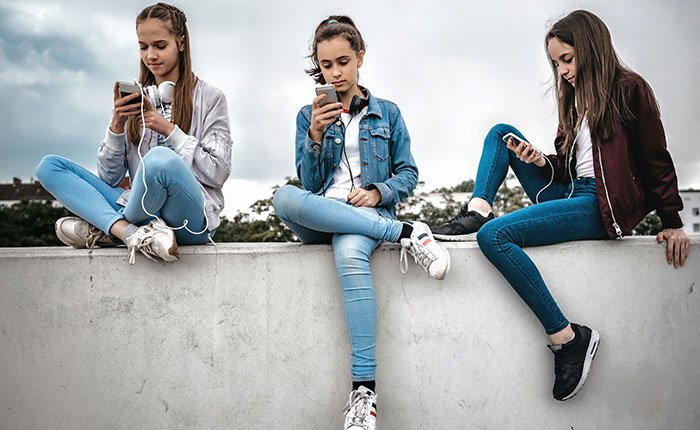Alcohol Advertising, Social Media and Young People
Each year the alcohol industry spends more than $100 million on alcohol advertising.
Given how extensive this is, young people (aged 12-24 years) often see many different forms of alcohol advertising (on tv, radio, billboards etc) – which can contribute to them taking up drinking, starting drinking at a much younger age, and engaging in risky drinking behaviours.(1-4)
Download the full report
The popularity of social media (Facebook, Instagram, Twitter, YouTube, etc.) has also created a unique digital environment where young people can be influenced by alcohol-related messages.

Alcohol brands (or ‘big alcohol’ companies) contribute to social media channels by using both direct (more obvious) and indirect (subtle) advertising techniques. This on-line content regularly breaches advertising laws and usually goes unchecked.1, 2
In these pages we will:
- explore alcohol advertising to young people through social media, why it is difficult to regulate, and why it can be harmful
- look at the different advertising techniques used by ‘big alcohol’ brands on social media, and how they can impact drinking behaviours – especially among young people
- consider what can be done by you and the young person in your life to reduce exposure to – and the impact of – these advertising practices.
The effectiveness of alcohol advertising on young people
Young people can be particularly influenced by alcohol advertising – especially as they don’t tend to recognise the intentions of advertisers until they are around the age of 16.7
They also often have stronger feelings of self-consciousness and concerns around identity8, which alcohol advertising can attempt to tap in to.
For example, alcohol ads often show drinking alcohol as something that will enhance mood or well-being, as well as contribute to positive emotional experiences, friendships, and achievement – all ideas which young people find appealing.4-7
Young people’s exposure to alcohol advertising can increase:
- intention to drink alcohol
- positive beliefs about alcohol
- likelihood of underage drinking
- level of alcohol consumed
- likelihood of hazardous or binge drinking.5, 8-10
Regulatory challenges
Alcohol advertising and marketing in Australia is self-regulatory and voluntary. This means the alcohol companies themselves are in charge of making sure their own Advertising Code is not breached.
The Code has ‘four key standards’ of responsible promotion:
- content cannot target minors or young people under 25 years of age
- content cannot encourage heavy or excessive drinking
- content cannot promote alcohol as a mood enhancer, therapeutic solution, or contributor to success
- content cannot show alcohol being consumed during an activity that requires safety precautions (such as driving or operating heavy machinery).
You can read the Code in more detail here.
Evidence suggests that:
- the Code and key standards are violated routinely
- there is bias in decision-making
- penalties are rarely handed out for advertisers who breach the Code
- very few complaints are upheld.1, 2
As a result, large amounts of unchecked marketing content is publicly released, which can be potentially harmful to young people and other vulnerable populations.1, 2
Through social media, alcohol brands are now targeting young people in new ways that are even more difficult to regulate than traditional advertising.
The failure of ‘age-gating’
‘Age-gating’ or ‘age verification’ technologies are protection measures used to restrict access to digital content from those that are not appropriately aged.
These techniques have been found to be ineffective on social media however, with young people able to access alcohol-related content quite easily.2
For example, a group of researchers who registered with underage profiles on YouTube had a 100% success rate when attempting to subscribe to alcoholic brands’ channels. They were also able to view two-thirds of the brands’ videos.11
In a separate study, fake underage profiles were able to access content posted by alcohol brands on Twitter and Instagram, and the underage Instagram profiles were able to receive alcohol-branded promotional materials.12
- Aiken A, Lam T, Gilmore W, Burns L, Chikritzhs T, Lenton S, et al. Youth perceptions of alcohol advertising: are current advertising regulations working? Australian and New Zealand Journal of Public Health. 2018;42(3):234-9.
- Noel JK, Sammartino CJ, Rosenthal SR. Exposure to Digital Alcohol Marketing and Alcohol Use: A Systematic Review. Journal of Studies on Alcohol and Drugs, Supplement. 2020(s19):57-67.
- Noel JK, Babor TF, Robaina K. Industry self-regulation of alcohol marketing: a systematic review of content and exposure research. Addiction. 2017;112(S1):28-50.
- Jernigan D, Noel J, Landon J, Thornton N, Lobstein T. Alcohol marketing and youth alcohol consumption: a systematic review of longitudinal studies published since 2008. Addiction. 2017;112(S1):7-20.
- Noel J, Lazzarini Z, Robaina K, Vendrame A. Alcohol industry self-regulation: who is it really protecting? Addiction. 2017;112(S1):57-63.
- Noel JK, Babor TF. Does industry self-regulation protect young people from exposure to alcohol marketing? A review of compliance and complaint studies. Addiction. 2017;112(S1):51-6.
- Zarouali B, Verdoodt V, Walrave M, Poels K, Ponnet K, Lievens E. Adolescents’ advertising literacy and privacy protection strategies in the context of targeted advertising on social networking sites: implications for regulation. Young Consumers. 2020;21(3):351-67.
- Jones S. Regulation of alcohol advertising: Policy options for Australia. Evidence Base. 2013;2.
- Weaver ERN, Wright CJC, Dietze PM, Lim MSC. ‘A Drink That Makes You Feel Happier, Relaxed and Loving’: Young People's Perceptions of Alcohol Advertising on Facebook. Alcohol and Alcoholism. 2016;51(4):481-6.
- Barry AE, Padon AA, Whiteman SD, Hicks KK, Carreon AK, Crowell JR, et al. Alcohol Advertising on Social Media: Examining the Content of Popular Alcohol Brands on Instagram. Substance Use & Misuse. 2018;53(14):2413-20.
- Barry AE, Johnson E, Rabre A, Darville G, Donovan KM, Efunbumi O. Underage Access to Online Alcohol Marketing Content: A YouTube Case Study. Alcohol and Alcoholism. 2015;50(1):89-94.
- Barry AE, Bates AM, Olusanya O, Vinal CE, Martin E, Peoples JE, et al. Alcohol Marketing on Twitter and Instagram: Evidence of Directly Advertising to Youth/Adolescents. Alcohol and Alcoholism. 2016;51(4):487-92.